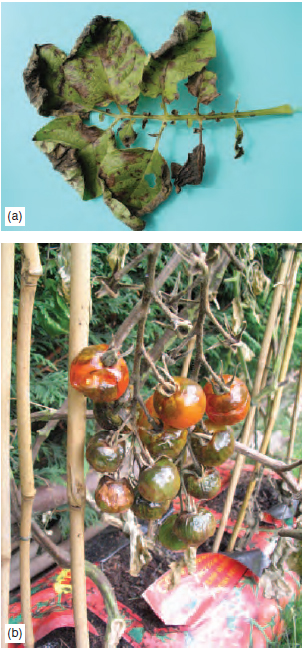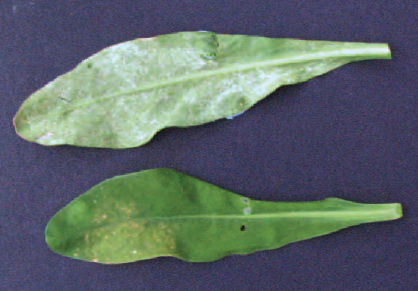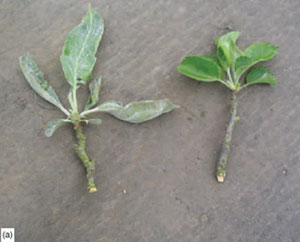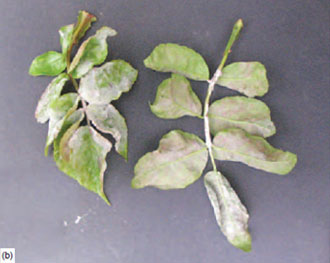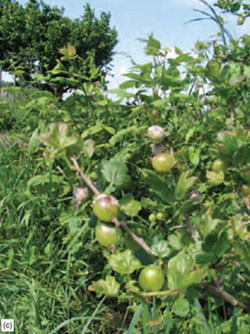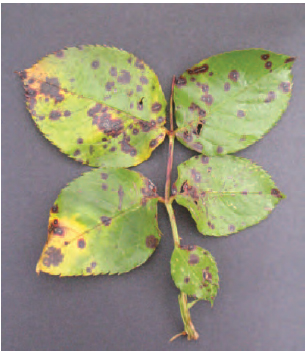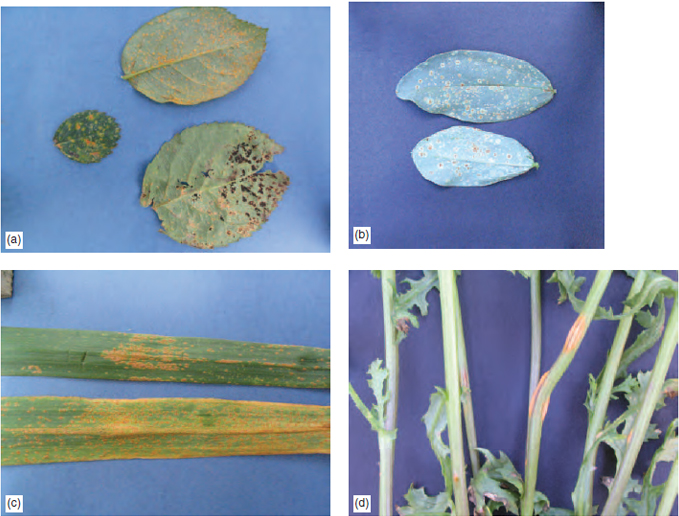Leaf and flower diseases
Content
Potato blight (Phytophthora infestans) This fungus is a member of the Zygomycota division of fungi Damage: This important disease is a constant threat to potato production; it caused the Irish potato famine in the nineteenth century. The first symptoms seen in the field are yellowing of the foliage, which quickly goes black and then produces a white bloom on the under surface of the leaf in damp weather. The stems may then go black, killing off the whole plant. The tubers may show dark surface spots that, internally, appear as a deep dry red-brown rot: This fungus may attack tomatoes, the most notable symptom being the dark-brown blisters on the fruit (Figure 15.5).
Life cycle: The fungus survives the winter as mycelium and sexual spores in the tubers (see Figure 15.4,). The spring emergence of infected shoots results in the production of asexual spores. Spread: The spores are spread by wind and land on potato leaves or stems. They can, after infection, result in a further crop of spores within a few days under warm, wet weather conditions. The disease can spread very quickly. Later in the crop, badly infected plants may have tuber infection as rainfall washes spores down into the soil. Control: The amateur gardener should use clean seed, choose resistant varieties, and apply a protective fungicide such as copper sulphate (Bordeaux mixture) before damp conditions appear. The professional grower similarly needs to use clean seed. Removal and herbicidal destruction, (e.g. using dichlobenil), of diseased tubers from stores or ‘clamps’ prevents disease spread. Knowledge of the disease’s moisture requirement leads to better control. DEFRA are able to measure both the duration of atmospheric relative humidity greater than 92 per cent, and mean daily temperatures greater than 10°C (together known as critical periods) , and to issue forecasts of potato blight outbreaks. In this way, protectant sprays of chemicals such as mancozeb can be applied before infection can take place. Resistant potato cultivars prevent rapid build-up of disease, although resistance may be overcome by newly occurring fungal strains. Early potato cultivars usually complete tuber production before serious blight attacks, while main-crop top growth may deliberately be killed off with foliage-acting herbicides, such as diquat, to prevent disease spread to tubers. A curative, systemic fungicide such as benalaxyl penetrates the leaf and kills the infecting mycelium. This ingredient has within its formulation a protectant ingredient (in this case mancozeb) to kill off most germinating spores and thus reduce the development of fungus resistance to the systemic fungicide. Downy mildew of cabbage and related plants (Perenospora brassicae) This fungus is a member of the Zygomycota group of fungi. Damage: This serious disease causes a white bloom mainly on the under surface of leaves (see Figure 15.6) which present a more favourable humid microclimate for infection and spore production than the upper leaf surface. Ornamental cruciferous plants such as stocks and wallflowers, brassicas such as cabbage and occasionally weeds such as shepherd’s purse are attacked by this fungus. The disease is most damaging when seedlings are germinating, particularly in spring when the young infectable tissues of the host plant and favourable damp conditions may combine to kill off a large proportion of the developing plants. Life cycle and spread: Asexual spores (zoospores) are produced on microscopic structures on the lower leaf surface, mainly in spring and summer, and are spread by wind currents. Thick-walled sexual spores (oospores) produced within the leaf tissues fall to the ground with the death of the leaf and survive the winter to initiate the spring infections, when rain splash carries the spores up to the lower leaf surface of seedlings and young plants. Control: It is not advisable to grow successive brassicas in the same field, and particularly not to sow in spring next to overwintered crops.
The amateur grower can use a product containing the protectant fungicide, mancozeb: The professional horticulturist uses a protective chemical such as chlorothalinal at the seedling stage to kill off spores on the leaf. A combination of a systemic fungicide metalaxyl plus chlorothalinal gives better control, while reducing the development of fungus strains resistant to the systemic ingredient. Other crops such as lettuce and onions are attacked by different downy mildews (Bremia lactucae and Perenospora destructor respectively) and no cross-infection is seen between crops belonging to different plant families. Powdery mildew of ornamental Malus and apple (Podosphaera leucotricha) This fungus belongs to the Ascomycota group of fungi. Damage: Powdery mildews should not be confused with downy mildews. Powdery mildew is distinguished by its dry powdery appearance, most commonly found on the upper surface of the leaf, and by its preference for hot, dry weather conditions (see examples of powdery mildew in Figure 15.7). Life cycle and spread: The disease survives the winter as mycelium within the buds which often appear small and shrivelled on twigs which often have a dried, silvery appearance. The emergence of the mycelium with the germinating buds in spring results in a white bloom over the young leaves (primary mildew) . As the spring progresses, asexual spores produced in chains on the upper surface of the leaf are spread as individual spores by wind and cause the destructive secondary mildew. This stage of the fungal life cycle involves an external mycelium covering the leaf surface, but not entering into the internal leaf tissues other than to sink small peg-like structures (which suck out the leaf’s moisture and may cause premature leaf drop). Flowering normally occurs before the secondary infection stage, but infection in young apple fruit may produce a rough skin (russeting). This organism may affect other species of fruit such as pears, quinces, medlars and ornamental Malus.
Powdery mildews in autumn may produce sexual, dark-coloured spore cases (cleistothecia) on the leaf, about 1 mm in size. (Although not important in most horticultural crops as an overwintering stage, they may assume a vital role in powdery mildew of cereals, the sexual spores having the potential to form new strains resistant to fungicides, and new strains capable of overcoming the plant’s genetic resistance.) Control is achieved by two main ‘methods’. Pruning of silvered shoots can eliminate a good proportion of the primary mildew. The amateur and professional horticulturist can use a systemic fungicide ingredient such as myclobutanil for spring and summer sprays, whilst the professional also has a protective fungicide option such as dinocap. Other species of powdery mildew commonly occur in horticulture, e.g. Sphaerotheca pannosa on rose (Figure 15.7) and S. fuliginea on cucumber. Cross-infection between these crops does not occur. Black spot of roses (Diplocarpon rosae) This fungus belongs to the Ascomycota group of fungi.
Life cycle and spread: Asexual spores (produced within spore cases embedded in the leaves) are released in wet and mainly warm weather conditions, and are then spread a few metres by rain drops or irrigation water before beginning the cycle of infection again. No overwintering sexual stage is seen in Britain, and it is probable that asexual spores surviving in autumn-produced wood or in fallen leaves begin the infection process again the following spring. Control: Removal of fallen leaves is a very important aspect of control. Resistance is not common in rose cultivars. Both amateur and professional horticulturists can use a systemic fungicide ingredient such as myclobutanil: The professional has also a protectant ingredient, captan which, while very effective against this disease, is limited in its action by the vigorous leaf expansion in late spring and summer which leaves unprotected areas of foliage. The addition of a wetter/spreader may improve control by spreading the active ingredient more effectively over the leaf surface. In industrial areas the sulphur dioxide in the air may be at a sufficient concentration to help reduce black spot. Carnation rust (Uromyces dianthi) Rust fungus belongs to the Basidiomycota group of fungi. (The rusts are a distinctive group of fungi which may have very complex life cycles involving five spore-forms within the same fungal species. When these different spore-forms occur on more than one host, e.g. blackcurrant rust (Cronartium ribicola), which attacks both blackcurrants and fiveneedle pines, the close planting of the two crops may give rise to high rust levels. For this reason, in some North American forested regions, blackcurrants may not be planted. Most horticultural rust species are found on only one host species.) Damage: Carnation rust first appears as an indistinct yellowing of the leaf and stem, soon turning into an elongated raised brown spot which yields brown dust (spores) when rubbed (see Figure 15.9). Life cycle and spread: The more common thin-walled spores (uredospores) are spread by wind currents and infect the leaf by way of the stomata in damp conditions. The less common thick-walled black spores (teleutospores) may survive and overwinter in the soil. The resistance of carnation cultivars varies, while related species, e.g. pinks or sweet williams, are rarely affected. Control: Preventative control includes the use of rust-free cuttings, sterilization of border soils and careful maintenance of greenhouse ventilators to prevent damp patches occurring in the crop. Amateur and professional horticulturist are able to spray products containing a systemic ingredient, myclobutanil, and products containing the protectant mancozeb:
The occurrence of white rust (Puccinia horiana) on chrysanthemums has created serious problems for the horticultural industry and for gardeners, because of the ease with which the disease is carried in cuttings and its speed of increase and spread. Other common rusts are found on antirrhinum, hollyhock, rose and leek, and more recently European pear rust, with an alternate host of juniper, has become more common in the UK. |
||||||||||||||||||||||||||||||||||||||||
